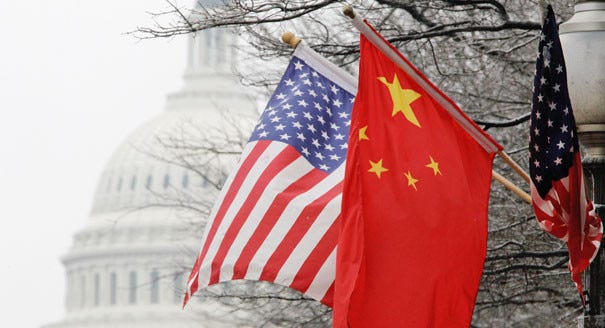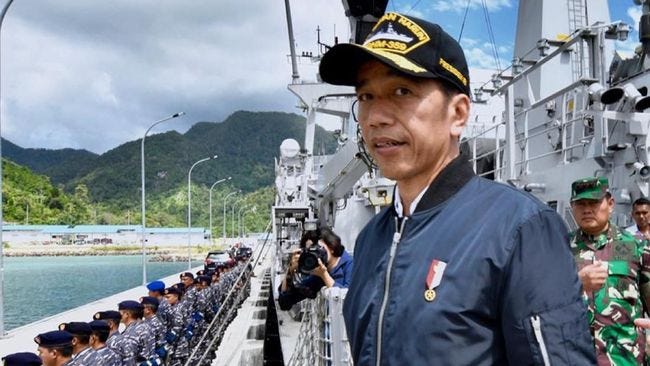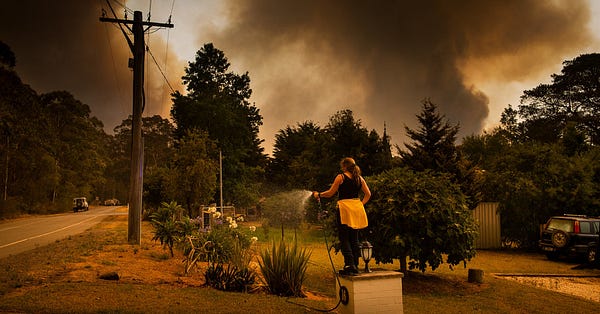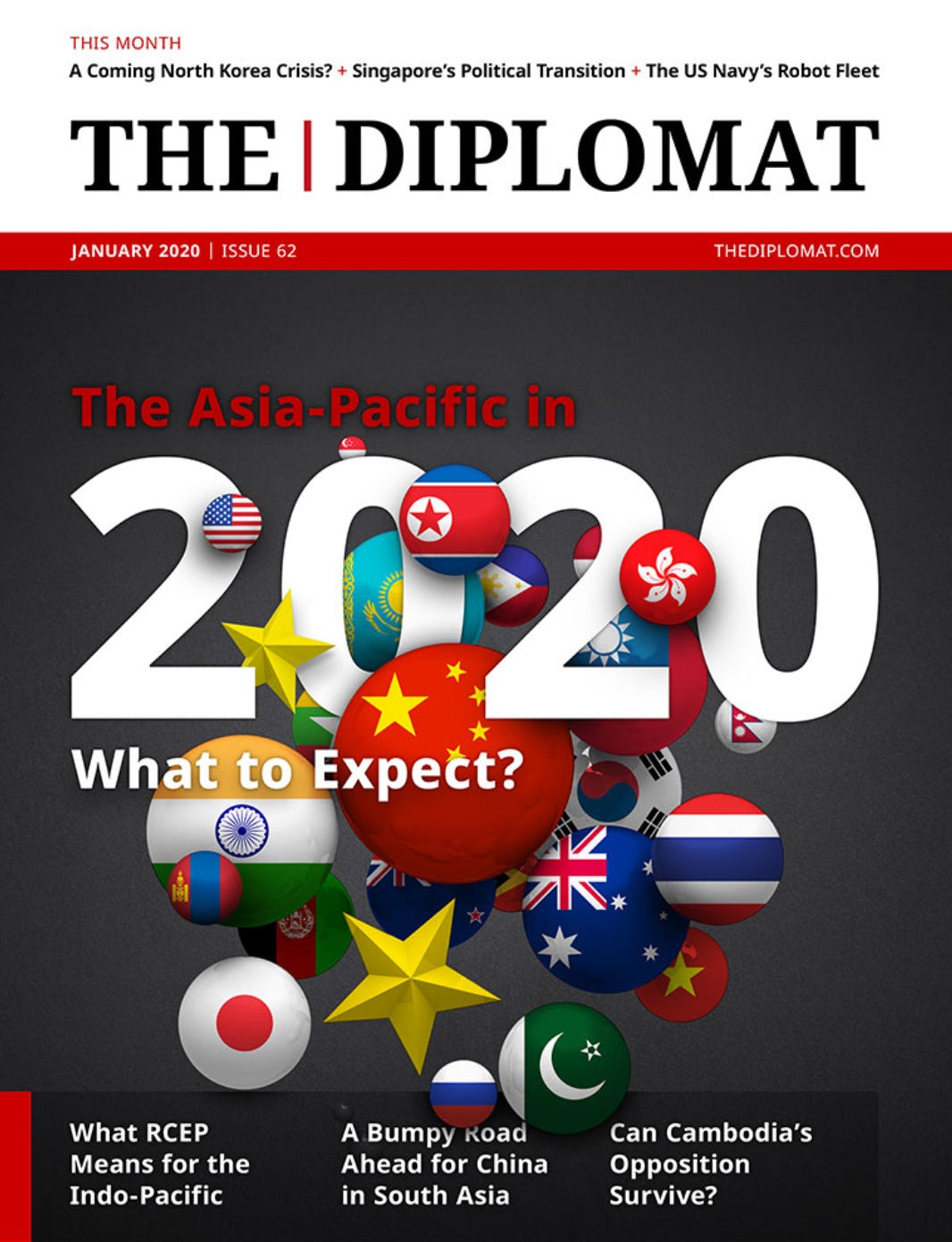Top Risks in Asia in Early 2020
What are the top issues and trends to keep an eye on early in 2020?
2020 in the Asia-Pacific is off to a busy start. What are the big things to watch for?

I hope everyone’s 2020 is off to a reasonable start. The pace of global events certainly did not slow down in the final days of 2019, with the U.S.-Iran crisis going from a slow simmer to an all-out boil. To kick off this year of newsletters, I want to offer a preview of what risks, trends, and events in the Asia-Pacific region you should be keeping on your radar as the new year begins. As a result, this issue will be a little different from the usual format, with a focus on the big stories that are likely to drive the year ahead.
The US Election
On November 3, American voters will be going to the polls to elect the person that’ll occupy the White House for a four year term starting on January 20, 2021. Donald J. Trump, the incumbent, will face off against whoever wins the Democratic Party’s primary, which will become known by the Democratic National Convention this summer. Given the Trump administration’s adoption of a drastically different approach to U.S. statecraft in Asia and around the world, it seems fitting to place the U.S. election as probably one of the more significant events this year in terms of its impact on Asia. Everything from the future of the U.S.-China trade war, the Korean Peninsula diplomatic process, and U.S. alliances depends on the outcome of this election. Four more years of Trump will look very different from four years under a Democratic administration. Democrats are thinking along very different lines when it comes to Asia policy too. (For an overview, see a recent piece by Van Jackson in The Diplomat’s magazine, outlining the basic foreign policy schools of thought within the party.)
Trade War: Year 3
Mid-2020 will mark the third year of the Trump administration’s trade war with China (as measured from the start of the first round of U.S. tariffs on Chinese exports). The year is certainly set to kick off on a high note, with equity markets bubbly on the news of an impending “phase one” deal signing. The deal was agreed in the final weeks of 2019. For an overview of what will feature in the “phase one” deal, see this from Reuters.
China has announced that Vice Premier Liu He, Beijing’s point man on trade talks with the United States, will travel to Washington to sign the agreement. The signing was announced by Trump on New Year’s Eve in a tweet promising that “high level representatives of China will be present.”

The third year of the trade war may begin on a relatively high note, but it’s questionable how sustainable the positive momentum might be. Progress toward an eventual successor deal -- a “phase two” agreement -- is expected to continue, but it’s unclear if both sides can be successful. It’s worth recalling that the U.S.-China relationship suffers from greater differences than what the term “trade war” allows. Even on economic terms, broader economic decoupling in the technology between the two sides is likely to continue and intensify. Tussles over Huawei in 2019 are just the start. Expect to see U.S. export controls on critical technologies continue to intensify, the U.S. Department of Justice continue to crack down on Chinese espionage and intellectual property theft, and Beijing continue its push for indigenous expertise and innovation to wean itself off reliance on U.S. technologies. The trade was is far from over.
Diplomat Risk Intelligence.

I’m excited to introduce a new offering from The Diplomat. Diplomat Risk Intelligence is the new consulting and analysis division of The Diplomat, the Asia-Pacific’s leading current affairs magazine. To learn more, click here.
India’s Political Drift
All is not well in India. I’ve made the case before in this newsletter that following its whopping general election mandate last year, combined with a slowing down of economic growth indicators, India’s ruling Bharatiya Janata Party has effectively gone all-in on its nationalist agenda. The BJP has done this by checking off at least a few items from its election manifesto. First, last August, the erstwhile state of Jammu and Kashmir was reorganized into two new union territories, ending a period of constitutionally sanctioned autonomy for India’s only Muslim-majority state. The move wasn’t only effectuated on paper: since August 5, 2019, India has had the Kashmir valley on lockdown, with a gradual slackening of some restrictions, but many of the most onerous signs of a crackdown remain in place.
Separately, much of India has been overtaken by protest and a sense of unease, with many Indian critics of Prime Minister Narendra Modi’s government alleging that an “undeclared emergency” has been imposed. Scenes from Delhi and Bangalore to Mumbai and Assam show widespread protests over a controversial new citizenship law, which, in combination with plans for a nationwide imposition of the National Register of Citizens, stands to strip Indian Muslims of citizenship should they be unable to prove their Indian citizenship. (Other religious minorities and even Hindus could lose their citizenship under the NRC, but the new citizenship law would allow for them to seek refuge in India -- with Muslims from neighboring South Asian states specifically excluded.)
Internal turmoil is affecting India’s democratic bona fides on the world stage and its diplomatic efforts writ large. Writing in December, I made the case that this will have effects on U.S.-India relations (and already has). In 2020, the world will be watching developments in India closely to see if the nationalist drift initiated by Modi and the BJP continues, or if it can be stemmed in any way. With no sign that the government is looking to buckle on its social agenda, the odds aren’t great, but the implication of an India that finds itself veering more and more toward illiberal democracy stands to be significant in Asia.
A New North Korea Crisis
Last year’s final newsletter closed with thoughts on North Korea, highlighting the then-impending end-of-year deadline that leader Kim Jong Un had set for the United States. That deadline is now behind us and, at a plenary of the Central Committee of North Korea’s ruling Workers’ Party of Korea, Kim said, among other things, that he would no longer observe his April 2018 moratorium on long-range missile and nuclear tests. (More on the full significance of the plenum here.)
The United States has yet to make any changes to its North Korea policy; negotiations are no longer happening. Given the quick spiraling out of the U.S.-Iran crisis amid confused and dangerous American decision-making, it’s not impossible to imagine a similar crisis with North Korea. February has traditionally marked the start of North Korea’s main missile-testing season and the spring may bring large joint U.S.-South Korea exercises. Trump has implied that he sees Kim Jong Un has a “man of his word” over his moratorium; the American president has repeatedly celebrated the lack of long-range missile tests (even as he was happy to overlook Kim’s many short-range tests last year). Watch this space with North Korea. Kim Jong Un, too, has indicated that he’s out to chart a much more defiant “offensive” line in his national policy.
A Busy Year in the South China Sea?
As 2019 came to a close, we got a reminder that South China Sea tensions weren’t about to go anywhere. Indonesia, which is not a territorial claimant in disputed waters, but does dispute part of its exclusive economic zone with China, complained to Beijing over activities by a China Coast Guard ship in waters that it claimed, calling it a “violation of sovereignty.” That capped off a year of similar complaints from other claimants, including Vietnam. As my colleague Prashanth Parameswaran has written this week “Indonesia’s current approach to the South China Sea has not proven successful in deterring Beijing’s incursion into Jakarta’s waters.”

2020 promises to be a significant year in the South China Sea, which very much remains one of Asia’s top flashpoints. Vietnam, one of the most outspoken South China Sea claimant states in recent years, is taking over the chairmanship of the Association of Southeast Asian Nations (ASEAN). Separately, China’s resolve to push its luck against claimant states like Vietnam, Indonesia, and even Malaysia remains undeterred. (Kuala Lumpur ended 2019 by filing a new submission on an extended continental shelf, surprising many observers.) China and the Philippines, meanwhile, are set to continue their competitive-cooperative relationship on South China Sea issues well into this year.
The fight for the future of the South China Sea isn’t over just yet.
Climate Risks?
Toward the end of 2019, Australia’s running bushfires reached apocalyptic proportions. As of writing, as much as 10.3 million hectares of land has been lost to the fires, an area the size of the territory of South Korea.


The fires emphasize the drastic and sudden impact climate risks can have on a region. In the Australian case, not only have the fires threatened to leave behind drastic ecological consequences, but entire communities have been transformed, with thousands displaced. In economic terms, the damage done by the fires is already estimated to be in excess of $4 billion, according to an estimate from Moody’s Analytics. This week, at long last, rain brought some limited relief to parts of Australia, but challenges remain ahead.
Australia isn’t the first and won’t be the last country in the Asian region to suffer from the consequences of changing climate patterns. Unpredictable and devastating natural disasters may continue to have a significant effect across the region. Yet the Morrison government in Australia continues to drag its heels on taking any climate change action, despite increasingly steep costs to its image at home and abroad.
What Else to Watch?
The above six points are short-term suggestions, but for a much deeper dive on the Asia-Pacific in 2020, make sure you check out at The Diplomat’s e-magazine. This month we look ahead at the key trends that will define the Asia-Pacific region in 2020, featuring a range of experts from our network of contributors.

We also analyze the diplomatic and economic impact of the RCEP mega trade deal, recap the latest ups and downs of China’s Belt and Road in South Asia, and take a hard look at the future of Cambodia’s political opposition. And, of course, we offer a range of reporting, analysis, and opinion from across the region.
Extras.
Much ink has been spilled on the implications of the ongoing U.S.-Iran tensions. I don’t mean to add to the noise, but I have found that international relations theorist Robert Jervis’ view for War on the Rocks is quite insightful:
In terms of escalation, the situation resembles an asymmetric game of chicken. Very high levels of violence are the worst outcomes for both the United States and Iran, but as Trump never tires of telling us, it would be even worse for Iran than for the United States. Washington presumably gains some bargaining advantage from the asymmetry, but only a limited amount. Both sides know that all-out violence is to be avoided, and this brings up what students of nuclear weapons call the stability-instability paradox, as each side can feel free to engage in violence at lower levels, knowing that the other side does not want to escalate to the top of the ladder. But presumably even if they have not read the relevant scholarship, both sides also know that things can get out of control and that the consequences of any further violence cannot be predicted with complete certainty.
This newsletter is written by Ankit Panda, senior editor for The Diplomat, and director of research at Diplomat Risk Intelligence. Please do feel free to reach out with comments, tips, and feedback at ankit@thediplomat.com and follow me on Twitter at @nktpnd and The Diplomat at @Diplomat_APAC.


